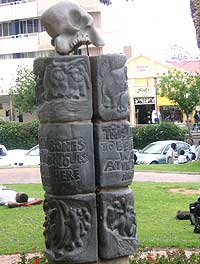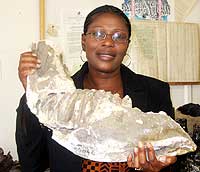|
The Zoo Park is a focal point of
social life in Windhoek. Residents
and visitors alike enjoy
relaxing times in the park usually unaware
of its prehistoric legacy and historical
development. There is very little
material culture that tells the story of
the park and yet archives abound with
references to its interesting history.
How much do the people who use
the park for various activities such
as music festivals or simply relaxing,
know about its past? When
did humans begin to live in the
area that we now know as Windhoek?
Is it correct for instance that Windhoek
was founded by Curt von Francois?
This
article visits the Zoo Park in prehistoric
period and brings into the public sphere
information that otherwise is locked up
in scientific papers, archives and relics.
Being such a focal point the Zoo Park
is well positioned as a space where public
memory revolves. In such a case history,
memory, tradition and the public
come together to create a collective
reminder of the past. The measure of
good history is in its contemporary usefulness. In other words people should
construct the usefulness of history in
their present. There must be a sense in
which history comes alive in the minds
of people when they encounter large and
silent artefacts such as parks.
Visitors to
the Zoo Park, for instance, should be
able to access the public memory that
the park represents. This is possible if
the city fathers/ mothers take into account
the rich history that the Zoo Park
represents and offer that to the residents
and visitors alike.
The area that we now know as Windhoek
today was inhabited from time
immemorial. Archaeological remains
of an elephant kill that took place close
to 5000 years ago in the Zoo Park attest
to a long legacy of occupation by
indigenous people.
It is known that as
recent as 1842 close to 2000 Oorlams
lived in Windhoek under their leader Jonker Afrikaner. They interacted in
many ways with the indigenous Damara,
Herero and Nama people found in
and around Windhoek. Jonker Afrikaner
gave the settlement its name
which was then spelt as Winterhoek.
Some people argue that the present
name, Windhoek, which came into use
in 1940 means ‘windy corner’
while others claim that Jonker
Afrikaner named it Winterhoek
after the place where his forefathers
originated from in South
Africa.
When Curt von François
arrived and decided to set up the modern
town of Windhoek he found the
Oorlams already there. The assertion
that he is the founder of Windhoek is
yet another myth in the history of the
city. Today von François is celebrated
with a prominent statue in front of
the Windhoek City Council building
while Jonker Afrikaner is remembered
through a road in Ausspanplatz. One of
the problems of African history is that
it “never” existed.
Scholars argue that
the distinction between history and
prehistory is that the historical period
is the era in which the written record exists. Such a definition relegates a better
chunk of African history (including
the case of the history of Windhoek)
to non-history, therefore not worthy of
preservation or even presentation to the
public.
In the case of the Zoo Park the
archaeological relics indicate a longer
history of the place and unfortunately
such an interesting part of pre-colonial
history of Windhoek escaped the public
memory because it is not well exposed.
Remains of three elephants were found
in the Zoo Park gardens during some
landscaping work in September 1961.
In addition to the elephant bones some
quartz stone tools such as  hammer
stones and choppers were also discovered.
The close association of the bones
and the stone tolls indicate that this was
a kill site. We learn from the discovery
that the Zoo Park was once well watered.
Possibly the elephants that were hunted
by the pre-colonial people had come to
drink from some of the several natural
fountains that characterised pre-colonial
Windhoek. hammer
stones and choppers were also discovered.
The close association of the bones
and the stone tolls indicate that this was
a kill site. We learn from the discovery
that the Zoo Park was once well watered.
Possibly the elephants that were hunted
by the pre-colonial people had come to
drink from some of the several natural
fountains that characterised pre-colonial
Windhoek.
The archaeologist who
excavated the site, Dr. Sydow, observed
at the time that the dark-grey humus
soil in which the elephant remains were
found could have been a swampy waterhole
where it got stuck and was killed.
The peaty soil in which the remains
were found is also an indication that the
area used to be marshy or even thickly
overgrown. Today one cannot see the
spring water flowing freely in the Zoo
Park because like other springs (hot and
cold) for which Windhoek was popular,
the water is now pumped for the town
supply. The stone tools suggest that the
elephants were cut up on the site and the
meat carried away. Radio carbon dates
published by H.R. MacCalman indicate
that the butchery of the elephants happened
approximately 5000 years ago.
This makes the Zoo Park elephant kill
one the oldest activities that were carried
out in our modern day city centre.
It shows that the habitation of the area
is historically long. Most importantly it
makes one wonder if not having written
history mean the absence of history?
How much more happened that was
not recorded because the society was
not yet literate?
The city of Windhoek is characterised
by monuments of the colonial period.
Such monuments are imposing and
prominent such that one cannot miss
them. However many people pass by
the Zoo Park and do not even recognise
the area where this prehistoric happening
took place. It is marked, yes, but the
Schultztruppe Memorial and the Chinese
Pavilion are more prominent and
beckoning.
Maybe the City council can
bring back the legacy of prehistoric existence
by displaying information about
the elephant kill? Maybe it is time to
create a public memory of pre-colonial
existence? The long and often neglected
memory of the Zoo Park can be retrieved
and made public. This can lead
to an edifying cultural experience. In
any case it certainly is time for African History to claim its place in an African
capital.
Fast facts about Zoo Park (Sources:
Stein and Lau 1989, The Namibian, August
2006)
1897:The first monument (Schultztruppe
Memorial) is erected in Windhoek.
It honours the German soldiers
who died in the war against Hendrick
Witbooi.
1904: The Park was known as the
Truppengarten or the Denkmalsgarten
from about
May 1911: The Park was
transferred by then government
to the Windhoek
Town Council
August 1916: The Town
Council applied to the
South African Occupation
forces for permission
to establish a zoo in
the park
October 1916: Café
Zoo opened
By 1930: The zoo
flourished with among
other animals leopard, duiker, porcupine,
jackal, guinea fowl, Kudu, ostrich
present.
1956: The park was reduced in size to
accommodate the widening of the then
Kaiser Street (Independence Ave) and
the straightening Peter Müller street
(Fidel Castro STR). Peter Müller Street
is reported to have run through the
park.
1960-1963: New lay out of the park is
carried out
 1961: Remains of an elephant kill are
discovered during the construction of a
new play area for kids. They date to
between 5000 and 20 000 years old. 1961: Remains of an elephant kill are
discovered during the construction of a
new play area for kids. They date to
between 5000 and 20 000 years old.
24 April 1963: the new garden is
opened
1966: The Café Zoo was demolished
May 1967: Zoo garden is renamed Dr.
Verwoerd Park
22 February 1989: Council renamed
the park Zoo Park
Ca.2000: Chinese Pavilion is constructed
2 May 2000: Construction of the New
Café Zoo commences
August 2006: in a new debate on the
name of the park Marcus Garvey Park
is suggested by a civil group called Africawise
Namibia
|

